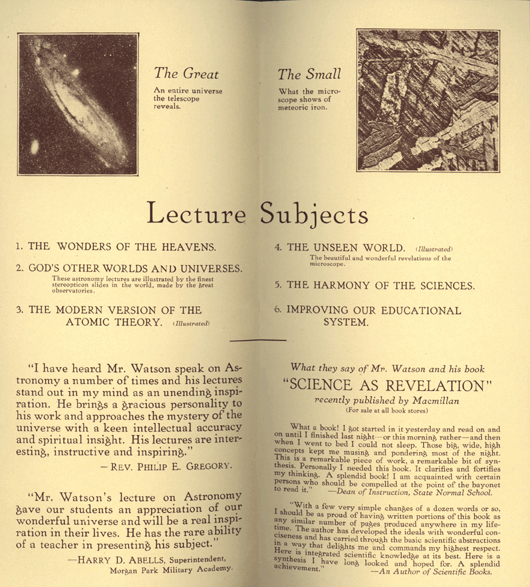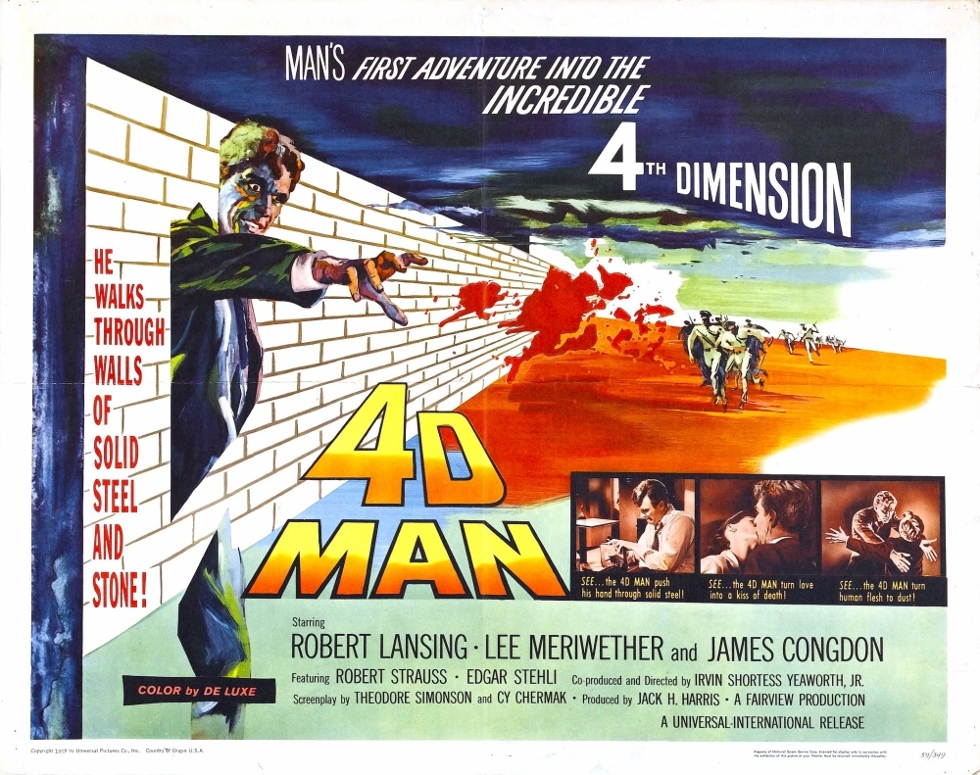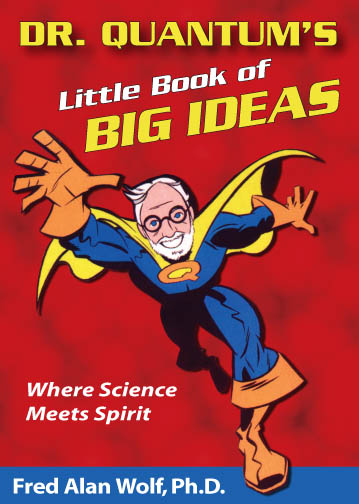belief-science
by Christopher White
A number of commentators have argued that in the last half century Christianity has declined in the West and a more generic belief in the supernatural has taken its place. According to this narrative, religion has declined and spirituality has increased.
Though there are problems with some of these arguments, in general I am persuaded by them. The question that arises for me, however, is this: If traditional religiousness is declining, where are these once-religious-now-spiritual people getting their ways of thinking about God, spirit, the afterlife, and related ideas? Out of what raw materials are they fashioning new beliefs about the transcendent realms of ghosts, gods or souls? One place, I think, is science.
At the turn of the twentieth century, many Europeans and Americans sensed that older traditions had failed them. That feeling accelerated during and after the Great War. When he filled out this survey in 1904, William James was helping one of his graduate students, James Bissett Pratt, who put this survey together as part of his doctoral research. James Pratt and many others were aware that older foundations for belief were crumbling and they experimented with ways of using psychology to understand what was authentically religious. Eventually they produced normative conclusions about the best ways to worship and the most healthy types of belief. Their recommendations were hard on traditional, institutional religions, and this became increasingly true by the middle of the twentieth century. They concluded that when old-time religious concepts were updated and made less superstitious, these concepts would become more believable.
James and his students also turned to psychological studies of religion to understand the nature and sources of belief and put its power on display. Attuned to matters relating to individual religion, these questionnaires themselves suggested that the essence of religion lay in the self. In the survey reprinted here, Pratt indicates that “personal experience” was more important than second-order “philosophical generalizations” that were removed from the vital sources of the religious self. In his earlier surveys of conversion, another student of William James, Edwin Starbuck, made the same move. And James also did the same thing in his 1901-2 Varieties. Pratt’s interpretive investment in personal experience is clear right at the beginning: he believes that religious institutions, rites and communities are less important. The essence of the thing to be surveyed—the essence of right religion—is inner experience.
James’s answers reflect some of the ways that religion was being torn down and spirituality built up in its place during this particular era. Did he believe in God because the Bible or some other more traditional source of religious knowledge told him so? Did he base his faith and life on the Bible? “No. No. No. It is so human a book that I don’t see how belief in its divine authorship can survive the reading of it.” Even prayer, a more traditional religious act, is forfeited here in favor of something else, perhaps study or discussion or analysis of religious experiences. Prayer made him feel “foolish and artificial.”
For James the most reliable source of religious knowledge was located in the inner stuff of emotions, will-power, and desire. He believed God existed because he felt a need for God. “I need it so that it ‘must’ be true.” He believed God existed because he needed a “more powerful ally of my own ideals.” He also believed in God (in a “dimly (real)” way) because he sensed the presence of a germ within him that responded to other peoples’ dramatic religious experiences. He didn’t have them himself, but he was thrilled to see that others did. The testimony of others he says here “is so strong that I am unable to pooh-pooh it away.” There was an emotional power behind the breathless way he and his students collected and shared thousands of these first-hand accounts. All of it was scientific proof for God and spiritual things.
James did not initiate the shift from religion to spirituality, though I think his life and indeed this questionnaire are emblematic of that shift in its earlier stages. After all, was not the shift from a robust institutional religiousness to a more individualistic spirituality inherent in Protestantism from the beginning? The older Protestant critique was a lot like James’s: get rid of inessential, outer religious forms and cling to inner, “spiritual” essentials—faith alone! James’s work was merely an extension of the paring down of religion that Protestants performed centuries before he came along.
There is another aspect of James’s purification of religion that is central to my argument, however, and it has to do with how he turned to an empirical study of experience as a new foundation for his spirituality. As older warrants for belief waned, as the Bible and even Jesus faded into a demythologized past, where could people turn to reestablish faith in God or immortality? The answer was science. When properly domesticated by religious believers, scientific procedures were ways of seeing spiritual things with certainty. With them we saw things truly, and seeing was believing. When James saw people around him falling into fits and trances, he believed. There was, he thought, something to it.
James wasn’t the only believer turning to science to appropriate its more certain ways of knowing, seeing, and believing.

John M. Watson’s starting point was similar to James’s in two ways. First, though he was willing to hold onto more of Christianity than James, he also believed that older ways of thinking about religion were superstitious, simple-minded and old-fashioned. Second, like James he believed that by studying the essence of religion in experience we could make religious experience more real to people and catch real glimpses of the divine spirit acting in these experiences.
But Watson also turns to other sciences to elicit another set of emotions that we might call religious: awe and wonder. In Watson’s Science as Revelation he insisted that a new vital faith might be had by studying not just human nature but also the beauty and lawfulness of nature in general. Science, in other words, was the alembic through which modern spiritual sensibilities were developed. “The new conception of God in the light of all the sciences as the intelligent energy, with many forms but with a single identity that fills the universe, is a thousand times more convincing than our former conceptions of Deity.” Watson used science to develop a new picture of God. “By the ladder of the sciences we may rise step by step, without the slightest break or gap,” Watson wrote, “from the simplest form of matter and energy and from nature at its zenith obtain the most sublime, beautiful and uplifting religious concepts.” God is energetic—a common belief among twentieth-century religious liberals—and the appropriate response to that God is openness, wonder, and astonishment.
There is a lot to be astonished about in Watson’s lecture tour of the universe, and participants evidently were appropriately awed. This is clear from the promotional pamphlet. Science was showing us that there was more to the world than meets the eye. Telescopes demonstrated that the world was more vast and wonderful than we had ever thought. And microscopes brought into focus another world within our world, a world of intricate crystals and microscopic ecologies. Both new technologies yielded “beautiful and wonderful revelations.” Both proved that there were things that existed beyond the range of our vision and both helped us see them. What else might be out there that we couldn’t yet see? Were there unseen dimensions where other creatures resided? You had to wonder.

Conversations about higher dimensions had already begun in the late nineteenth century, when scientists used higher dimensional math to understand better the universe’s laws. Beginning at the turn of the twentieth century, theologians and writers borrowed these ideas to try to “prove” the existence of heaven, explain the mechanisms involved in spirit communication or understand better the fate of dearly departed souls. Films and books about higher dimensions also made people wonder. This 1959 film was only one of the many imaginative narratives that depicted scientists with new powers and access to other worlds.
The 4D Man told the story of two brothers who developed an “amplifier” that enabled them to have fourth dimensional powers. (Basically, they could pass through walls.) In the fourth dimension, however, time moved more rapidly, and passing into the 4D therefore meant aging quickly. (There were downsides to wandering into other planes of existence.) The same themes were played out in a 1963 episode of the sci-fi TV show The Outer Limits, though here the 4D machine transported people (briefly) to a plane of existence that looked like a shadowy afterlife where scientists could call out for spirits of lost loved ones. This show began with the cast around a séance table. It ended with a successful journey to the 4D/heaven in a scientific laboratory.
The film and the TV show suggest ways that Americans borrowed scientific ideas about other dimensions to help them imagine the existence of unseen realms and recover an imaginative sense for the supernatural. Books about other dimensions—some theological but many sci-fi or fiction—did the same thing. In the last thirty years, with the rise of multidimensional string theory, there are more and more popularizations of science that religious people take up with enthusiasm and wonder. Science and science fiction point the way to uncanny, mysterious, and otherworldly realities.
That the universe is uncanny and mysterious is admitted even by more sober physicists today. Fred Alan Wolf is not one of them. He is a scientific mystic with a fantastic superhero alter ego—Dr. Quantum—who, like the 4D scientists in The 4D Man, found new powers and abilities in twentieth-century science.

Wolf received his PhD in theoretical physics at UCLA in 1963 and actively worked in the field until a 1971 sabbatical trip to India and Katmandu, where he had his first religious experience in a Buddhist temple. He left his academic position at San Diego State University in 1974 and set out with a few friends and left wing physicists to create the Fundamental Fysiks Group in San Francisco, a group that used quantum principles to explain ESP, psychokinesis, occult phenomena, and spirit communication. Since then Wolf has written popular books about spirituality, consciousness, and quantum physics. The image reproduced here is from one of these books.
What happens when, as it says on the cover, “science meets spirit”? Wolf and other quantum mystics have identified several ways that scientific thinking has led to new religious ideas. I can enumerate three here:
1. Quantum science shows us that the natural world is mysterious, uncanny, and multidimensional. Nature dissolves into energetic forces that elude the epistemologies of measurement and control scientists have traditionally used. All things can look like particles or waves but at bottom are different forms of energy vibrating at different frequencies.
2. God is an immanent force in this energetic world, or perhaps is coextensive with this energetic world.
3. Mind or spirit is the source of all realities and things. If in former times it seemed true that mind/spirit was epiphenomenal and the material world was the only real reality, today the reverse is true: the material world is epiphenomenal and mind/spirit is the only reality. (Wolf and others reach this conclusion by interpreting the observer effect in quantum physics. Long story.) The preoccupation with the power of the mind or consciousness to shape or determine reality is a preoccupation that increases as the twentieth century wears on, though it is unmistakably present in James as well, who believed our intentions shaped reality and who argued that our consciousness contained mysterious powers of mystical perception.
My argument in this short piece has been pretty simple. It is that twentieth-century believers have appropriated ideas from the sciences (and especially from popular science publications) to fashion new ways of thinking about God and the transcendent. There is no doubt that Americans draw on a range of ideas and images as they reimagine religious concepts. But science has a privileged place in our culture. It is probably the most powerful source of certain knowledge. Why not incorporate its key metaphors and concepts as we try to understand where Americans get their ideas about the world, its mysterious qualities, ineradicable ghosts, and transcendent boundaries?
